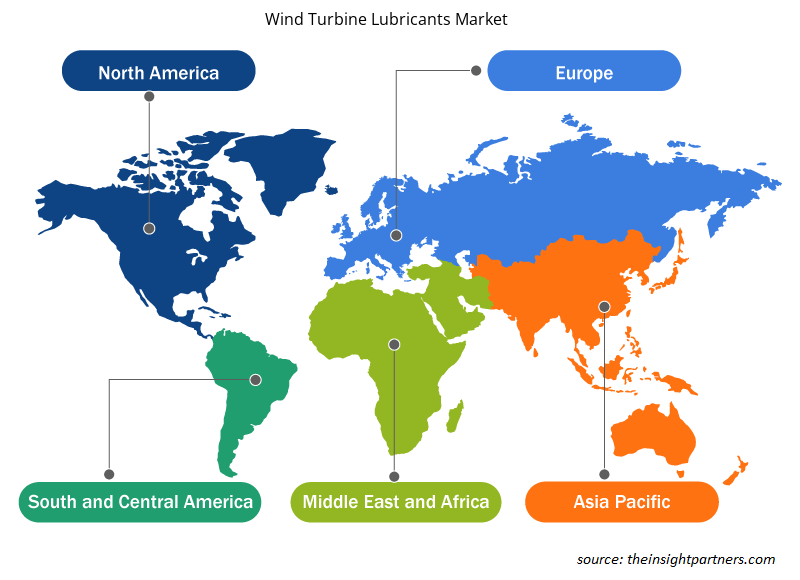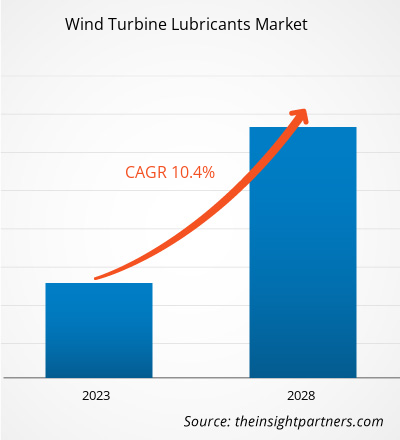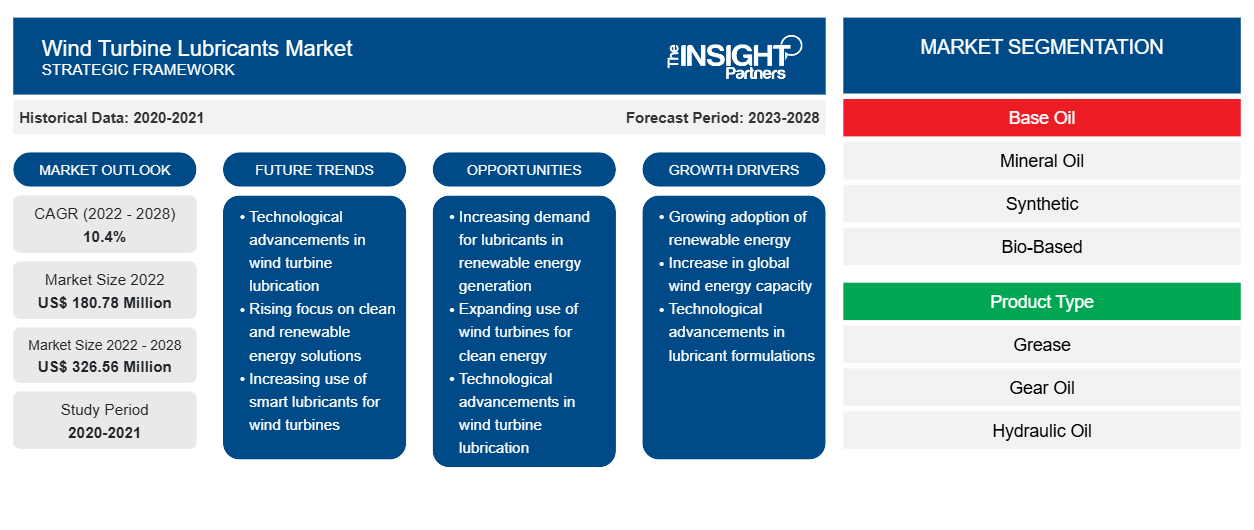[Rapport de recherche] La taille du marché des lubrifiants pour éoliennes devrait passer de 180,78 millions USD en 2022 à 326,56 millions USD d'ici 2028 ; elle devrait enregistrer un TCAC de 10,4 % de 2022 à 2028.
Les lubrifiants pour éoliennes jouent un rôle important dans le fonctionnement, la maintenance et la fiabilité des équipements des parcs éoliens. Les éoliennes ont différents points de lubrification tels que la boîte de vitesses, l'engrenage ouvert, l'engrenage de pas, le palier de pas, le palier de lacet, les systèmes hydrauliques et les paliers du générateur. Les différents lubrifiants utilisés dans les éoliennes sont les huiles pour engrenages, les huiles hydrauliques et les graisses. L'huile pour engrenages est utilisée pour lubrifier les boîtes de vitesses. Dans les éoliennes, la graisse est utilisée sur le palier de l'arbre du rotor principal, le palier de lacet, les engrenages d'entraînement de pas, le palier des pales et le palier du générateur.
Français La part de marché mondiale des lubrifiants pour éoliennes pour l'Asie-Pacifique était la plus importante en 2022. Le marché des lubrifiants pour éoliennes en Asie-Pacifique est segmenté en Australie, Chine, Inde, Japon, Corée du Sud et reste de l'Asie-Pacifique. La Chine contribue largement à la croissance du marché dans cette région. Le pays est le producteur d'énergie renouvelable le plus important et celui qui connaît la croissance la plus rapide au monde depuis plus d'une décennie. De plus, il possède le plus grand marché de l'énergie éolienne au monde. La Chine est restée le plus grand marché mondial pour les nouveaux ajouts terrestres en 2020, grâce à la coupure du tarif de rachat garanti (FiT). L'Inde a également enregistré une croissance remarquable de l'industrie de l'énergie éolienne en raison de diverses politiques et réglementations favorables adoptées par les gouvernements nationaux et des États. En outre, des pays comme Taïwan, la Corée du Sud, le Vietnam et les Philippines prennent également diverses initiatives pour accroître leurs capacités éoliennes installées, augmentant ainsi la demande de lubrifiants pour éoliennes de la région.
Personnalisez ce rapport en fonction de vos besoins
Vous bénéficierez d'une personnalisation gratuite de n'importe quel rapport, y compris de certaines parties de ce rapport, d'une analyse au niveau des pays, d'un pack de données Excel, ainsi que de superbes offres et réductions pour les start-ups et les universités.
- Obtenez les principales tendances clés du marché de ce rapport.Cet échantillon GRATUIT comprendra une analyse de données, allant des tendances du marché aux estimations et prévisions.
Impact de la pandémie de COVID-19 sur le marché des lubrifiants pour éoliennes
Le soutien gouvernemental aux énergies renouvelables et l'augmentation des installations d'éoliennes ont largement contribué à la croissance du marché des lubrifiants pour éoliennes. Cependant, en 2020, diverses industries ont dû ralentir leurs opérations en raison de perturbations de la chaîne de valeur causées par les restrictions aux frontières nationales et internationales. Cela a conduit à la fermeture des installations de production, ce qui a eu un impact négatif sur la croissance du marché des lubrifiants pour éoliennes au début de 2020. Le déclin des installations éoliennes au début de 2020 a freiné la demande de lubrifiants pour éoliennes.
Cependant, le secteur de l'énergie éolienne a rebondi avec vigueur au cours du second semestre de l'année, les marchés éoliens matures et émergents ayant commencé à surmonter les impacts de la pandémie. En outre, le marché mondial a commencé à se remettre des pertes subies plus tôt pendant la pandémie, les gouvernements de différents pays ayant annoncé un assouplissement des restrictions sociales. En outre, l'augmentation des taux de vaccination a créé un environnement propice au progrès industriel. Selon le Global Wind Energy Council, l'industrie éolienne mondiale a connu une croissance annuelle record de 53 % en 2020. L' industrie a installé plus de 93 GW d'énergie éolienne au plus fort de la pandémie de COVID-19, malgré les perturbations de la chaîne d'approvisionnement mondiale et de la construction de projets . Une augmentation de la capacité éolienne installée a entraîné une augmentation de la demande de lubrifiants pour éoliennes, car les lubrifiants sont utilisés pour lubrifier différentes parties des éoliennes.
Informations sur le marché
L'augmentation de la capacité éolienne installée renforce la demande en lubrifiants pour éoliennes
Français L'énergie éolienne contribue à réduire la dépendance aux combustibles fossiles, ce qui se traduit par un intérêt croissant pour cette ressource renouvelable dans différents pays. Selon le « Global Wind Report 2021 » publié par le Global Wind Energy Council, en 2020, les nouvelles installations éoliennes ont dépassé les 90 GW, soit 53 % de plus que la capacité ajoutée en 2019. Cela s'est traduit par une capacité installée totale de 743 GW dans le monde, enregistrant une augmentation de 14 % par rapport à 2019. En 2020, les nouvelles installations dans les parcs éoliens terrestres ont atteint 86,9 GW, tandis que les parcs éoliens offshore ont atteint 6,1 GW, faisant de 2020 l'année la plus élevée et la deuxième année la plus élevée de l'histoire pour les nouvelles installations éoliennes terrestres et offshore, respectivement. Diverses pièces de l'éolienne doivent être lubrifiées à l'aide de graisses, d'huiles pour engrenages, d'huiles hydrauliques et d'autres lubrifiants. Par conséquent, l'augmentation de la capacité éolienne installée à l'échelle mondiale stimule la croissance du marché des lubrifiants pour éoliennes.
Informations sur les huiles de base
En fonction de l'huile de base, le marché mondial des lubrifiants pour éoliennes est segmenté en huiles minérales, synthétiques et biosourcées. Le segment synthétique détenait la plus grande part de marché des lubrifiants pour éoliennes en 2022. Les lubrifiants synthétiques sont constitués de composants pétroliers qui ont été fabriqués synthétiquement par la réaction de quelques composés chimiques bien définis, qui sont souvent à base de pétrole plutôt que raffinés à partir de pétrole brut ou d'huiles végétales existantes. Les lubrifiants synthétiques sont les lubrifiants les plus couramment utilisés dans l'industrie des éoliennes, car les huiles synthétiques ont un point d'écoulement plus bas, ce qui permet au réducteur de fonctionner efficacement à des températures plus basses.
Les principaux acteurs du marché mondial des lubrifiants pour éoliennes sont TotalEnergies, Exxon Mobil Corporation, FUCHS, BP plc, Klüber Lubrication, Shell, Phillips 66 Company, Chevron, Afton Chemical, AMSOIL INC. et The Lubrizol Corporation. Les acteurs du marché mondial se concentrent sur la fourniture de produits de haute qualité pour répondre à la demande des clients. Pour cela, ils investissent considérablement dans les activités de recherche et développement.
Rapports en vedette
- Tendances industrielles progressistes sur le marché des lubrifiants pour éoliennes pour aider les acteurs à développer des stratégies efficaces à long terme
- Stratégies de croissance des entreprises adoptées par les marchés développés et en développement
- Analyse quantitative du marché des lubrifiants pour éoliennes de 2020 à 2028
- Estimation de la demande mondiale en lubrifiants pour éoliennes
- Analyse des cinq forces de Porter pour illustrer l'efficacité des acheteurs et des fournisseurs opérant dans l'industrie
- Développements récents pour comprendre le scénario concurrentiel du marché
- Tendances et perspectives du marché, ainsi que facteurs qui stimulent et freinent la croissance du marché des lubrifiants pour éoliennes
- Aide à la prise de décision en mettant en évidence les stratégies de marché qui sous-tendent l'intérêt commercial, conduisant à la croissance du marché
- La taille du marché des lubrifiants pour éoliennes à différents niveaux
- Aperçu détaillé et segmentation du marché, ainsi que de la dynamique de l'industrie des lubrifiants pour éoliennes
- La taille du marché des lubrifiants pour éoliennes dans diverses régions avec des opportunités de croissance prometteuses
Aperçu régional du marché des lubrifiants pour éoliennes
Les tendances régionales et les facteurs influençant le marché des lubrifiants pour éoliennes tout au long de la période de prévision ont été expliqués en détail par les analystes d’Insight Partners. Cette section traite également des segments et de la géographie du marché des lubrifiants pour éoliennes en Amérique du Nord, en Europe, en Asie-Pacifique, au Moyen-Orient et en Afrique, ainsi qu’en Amérique du Sud et en Amérique centrale.

- Obtenez les données régionales spécifiques au marché des lubrifiants pour éoliennes
Portée du rapport sur le marché des lubrifiants pour éoliennes
| Attribut de rapport | Détails |
|---|---|
| Taille du marché en 2022 | 180,78 millions de dollars américains |
| Taille du marché d'ici 2028 | 326,56 millions de dollars américains |
| Taux de croissance annuel composé mondial (2022-2028) | 10,4% |
| Données historiques | 2020-2021 |
| Période de prévision | 2023-2028 |
| Segments couverts | Par huile de base
|
| Régions et pays couverts | Amérique du Nord
|
| Leaders du marché et profils d'entreprises clés |
|
Densité des acteurs du marché des lubrifiants pour éoliennes : comprendre son impact sur la dynamique commerciale
Le marché des lubrifiants pour éoliennes connaît une croissance rapide, tirée par la demande croissante des utilisateurs finaux en raison de facteurs tels que l'évolution des préférences des consommateurs, les avancées technologiques et une plus grande sensibilisation aux avantages du produit. À mesure que la demande augmente, les entreprises élargissent leurs offres, innovent pour répondre aux besoins des consommateurs et capitalisent sur les tendances émergentes, ce qui alimente davantage la croissance du marché.
La densité des acteurs du marché fait référence à la répartition des entreprises ou des sociétés opérant sur un marché ou un secteur particulier. Elle indique le nombre de concurrents (acteurs du marché) présents sur un marché donné par rapport à sa taille ou à sa valeur marchande totale.
Les principales entreprises opérant sur le marché des lubrifiants pour éoliennes sont :
- TotalEnergies SE
- BP SA
- Chevron
- Société Exxon Mobil
- Huile à pétrole FUCHS SE
Avis de non-responsabilité : les sociétés répertoriées ci-dessus ne sont pas classées dans un ordre particulier.

- Obtenez un aperçu des principaux acteurs du marché des lubrifiants pour éoliennes
Marché des lubrifiants pour éoliennes
En fonction de l'huile de base, le marché des lubrifiants pour éoliennes est segmenté en huile minérale, huile synthétique et huile biosourcée. Le marché mondial des lubrifiants pour éoliennes est segmenté en fonction du type de produit en graisse, huile pour engrenages, huile hydraulique et autres.
Profils d'entreprise
- TotalEnergies SE
- BP SA
- Chevron
- Société Exxon Mobil
- Huile à pétrole FUCHS SE
- Klüber Lubrication GmbH & Co.
- Société Phillips 66
- Shell Plc
- La société Lubrizol
- Chimie Afton
- AMSOIL INC.
- Analyse historique (2 ans), année de base, prévision (7 ans) avec TCAC
- Analyse PEST et SWOT
- Taille du marché Valeur / Volume - Mondial, Régional, Pays
- Industrie et paysage concurrentiel
- Ensemble de données Excel
Rapports récents
Rapports connexes
Témoignages
Raison d'acheter
- Prise de décision éclairée
- Compréhension de la dynamique du marché
- Analyse concurrentielle
- Connaissances clients
- Prévisions de marché
- Atténuation des risques
- Planification stratégique
- Justification des investissements
- Identification des marchés émergents
- Amélioration des stratégies marketing
- Amélioration de l'efficacité opérationnelle
- Alignement sur les tendances réglementaires





















 Obtenez un échantillon gratuit pour - Marché des lubrifiants pour éoliennes
Obtenez un échantillon gratuit pour - Marché des lubrifiants pour éoliennes